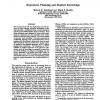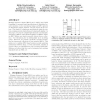375 search results - page 55 / 75 » Unified Modeling Language 2.0 |
AIPS
1996
13 years 10 months ago
1996
Weare concerned with the implications and interactions of three commonexpressive extensions to classical planning: conditional plans, context-dependent actions, and nondeterminist...
ECAI
2010
Springer
13 years 9 months ago
2010
Springer
Artificial agents trying to achieve communicative goals in situated interactions in the real-world need powerful computational systems for conceptualizing their environment. In ord...
SOSYM
2002
13 years 8 months ago
2002
The Unified Modeling Language (UML) has gained wide acceptance in very short time because of its variety of well-known and intuitive graphical notations. However, this comes at the...
WWW
2011
ACM
13 years 3 months ago
2011
ACM
This paper uses the URL word breaking task as an example to elaborate what we identify as crucialin designingstatistical natural language processing (NLP) algorithmsfor Web scale ...
SIGSOFT
2007
ACM
14 years 9 months ago
2007
ACM
Message Sequence Charts (MSCs) are a widely used visual formalism for scenario-based specifications of distributed reactive systems. In its conventional usage, an MSC captures an ...


